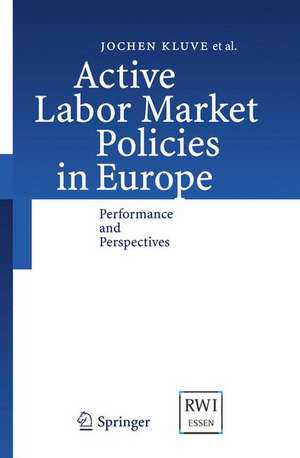Active Labor Market Policies in Europe: Performance and Perspectives
Autor Jochen Kluve, David Card, Michael Fertig, Marek Góra, Lena Jacobi, Peter Jensen, Reelika Leetmaa, Leonhard Nima, Eleonora Patacchini, Sandra Schaffner, Christoph M. Schmidt, Bas van der Klaauw, Andrea Weberen Limba Engleză Hardback – 3 ian 2007
| Toate formatele și edițiile | Preț | Express |
|---|---|---|
| Paperback (1) | 778.13 lei 6-8 săpt. | |
| Springer Berlin, Heidelberg – 13 oct 2010 | 778.13 lei 6-8 săpt. | |
| Hardback (1) | 782.42 lei 6-8 săpt. | |
| Springer Berlin, Heidelberg – 3 ian 2007 | 782.42 lei 6-8 săpt. |
Preț: 782.42 lei
Preț vechi: 954.17 lei
-18% Nou
Puncte Express: 1174
Preț estimativ în valută:
149.76€ • 162.73$ • 125.88£
149.76€ • 162.73$ • 125.88£
Carte tipărită la comandă
Livrare economică 19 aprilie-03 mai
Preluare comenzi: 021 569.72.76
Specificații
ISBN-13: 9783540485575
ISBN-10: 3540485570
Pagini: 236
Ilustrații: X, 222 p.
Dimensiuni: 155 x 235 x 18 mm
Greutate: 0.45 kg
Ediția:2007
Editura: Springer Berlin, Heidelberg
Colecția Springer
Locul publicării:Berlin, Heidelberg, Germany
ISBN-10: 3540485570
Pagini: 236
Ilustrații: X, 222 p.
Dimensiuni: 155 x 235 x 18 mm
Greutate: 0.45 kg
Ediția:2007
Editura: Springer Berlin, Heidelberg
Colecția Springer
Locul publicării:Berlin, Heidelberg, Germany
Public țintă
ResearchDescriere
Measures of Active Labor Market Policy - such as training, wage subsidies, public employment measures, and job search assistance - are widely used in European countries to combat unemployment. Little, however, is known about what each country can learn from experiences in other countries. This study provides novel insight on this important policy issue by discussing the role of the European Commission's Employment Strategy, reviewing the experiences made in European states, and giving the first ever quantitative assessment of the existing cross-country evidence, answering the question "what labor market program works for what target group under what (economic and institutional) circumstances?". Using an innovative meta-analytical approach, the authors find that rather than contextual factors such as labor market institutions or the business cycle, it is almost exclusively the program type that matters for program effectiveness: While direct employment programs in the public sector appear detrimental, wage subsidies and "Services and Sanctions" can be effective in increasing participants' employment probability.
Cuprins
Executive summary.- and overview.- The European Employment Strategy.- An overview of Active Labor Market Policies.- The methodology of program evaluation.- Reports from selected EU25 member states.- The effectiveness of European ALMPs.- Conclusions and policy recommendations.
Recenzii
From the reviews:“The book presents the results of a cross-country study on the effectiveness of active labour market policies. … A main function of the book is certainly to provide condensed information on the design of active labour market policies in a number of countries a well as information about their estimated effectiveness. … used as a quick reference when searching information in this field … . Summing up, the book covers lots of interesting material.” (Gesine Stephan, Papers in Regional Science, Vol. 87 (3), August, 2008)
Textul de pe ultima copertă
Measures of Active Labor Market Policy - such as training, wage subsidies, public employment measures, and job search assistance - are widely used in European countries to combat unemployment.
Little, however, is known about what each country can learn from experiences in other countries.
This study provides novel insight on this important policy issue by
- discussing the role of the European Commission's Employment Strategy
- reviewing the experiences made in European states
- and giving the first ever quantitative
assessment of the existing cross-country evidence, answering the question "what labor market program works for what target group under what (economic and institutional) circumstances?".
Using an innovative meta-analytical approach, the authors find that rather than contextual factors such as labor market institutions or the business cycle, it is almost exclusively the program type that matters for program effectiveness: While direct employment programs in the public sector appear detrimental, wage subsidies and "Services and Sanctions" can be effective in increasing participants' employment probability.
Little, however, is known about what each country can learn from experiences in other countries.
This study provides novel insight on this important policy issue by
- discussing the role of the European Commission's Employment Strategy
- reviewing the experiences made in European states
- and giving the first ever quantitative
assessment of the existing cross-country evidence, answering the question "what labor market program works for what target group under what (economic and institutional) circumstances?".
Using an innovative meta-analytical approach, the authors find that rather than contextual factors such as labor market institutions or the business cycle, it is almost exclusively the program type that matters for program effectiveness: While direct employment programs in the public sector appear detrimental, wage subsidies and "Services and Sanctions" can be effective in increasing participants' employment probability.
Caracteristici
First comparison of results of active labor market policies in Europe
Gives clear recommendations concerning successful policies and those that are not successful
Includes supplementary material: sn.pub/extras
Gives clear recommendations concerning successful policies and those that are not successful
Includes supplementary material: sn.pub/extras















